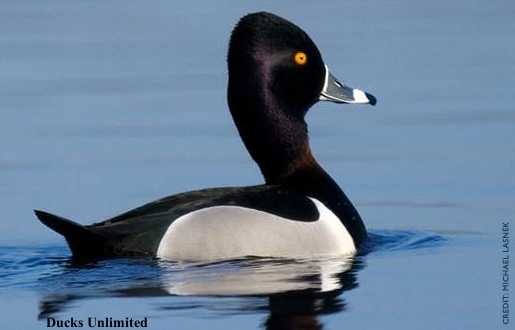 Ring-Necked
Duck Ring-Necked
DuckAythya collaris
Description
An adult male ring-necked duck
has a large body that is about 7½ to 8 inches
long; the female is slightly smaller. His head,
neck and breast are black, he has gray flanks,
and there is a white crescent separating the
flanks from the breast. The female has tan sides,
a brown back and a white belly. Both sexes have a
black tip and ring of gray on their bill,
although the female's bill ring is less
pronounced than the male's.
Distribution and
Habitat
Ring-necked ducks are found
across North America, except for the arctic
regions, as well as in the West Indies. They
breed in sedge-meadow marshes, swamp, and bogs
with waters ranging from fresh to somewhat
acidic.
Reproduction
Pairing begins in March and
April; nesting begins in May.
The nest is built on a floating
island or in an open marsh. The female selects
the nesting site and does all the work of
building the nest herself. Clutches typically
contain 8 or 9 milky white eggs, but can range
from 6 to 14. The female incubates the eggs for
26 or 27 days.
Diet
About eighty percent of a
ring-neck's diet consists of pondweeds, seeds,
and tubers, with pondweeds being the major
component. The other twenty percent consists of
insect larvae, mollusks, worms, and crustaceans.
Habits and Behaviors
Ring-necked ducks migrate in
small groups and nest close to each other. Males
and females usually stay in separate groups until
mating season.
Scientific
Classification
phylum Chordata
subphylum Vertebrata
class Aves
order Anseriformes
family Anatidae
subfamily Anatinae
genus & species Aythya collaris

Animal Diversity Web http://animaldiversity.org/accounts/Aythya_collaris/
Questions or comments about
this page?
|



